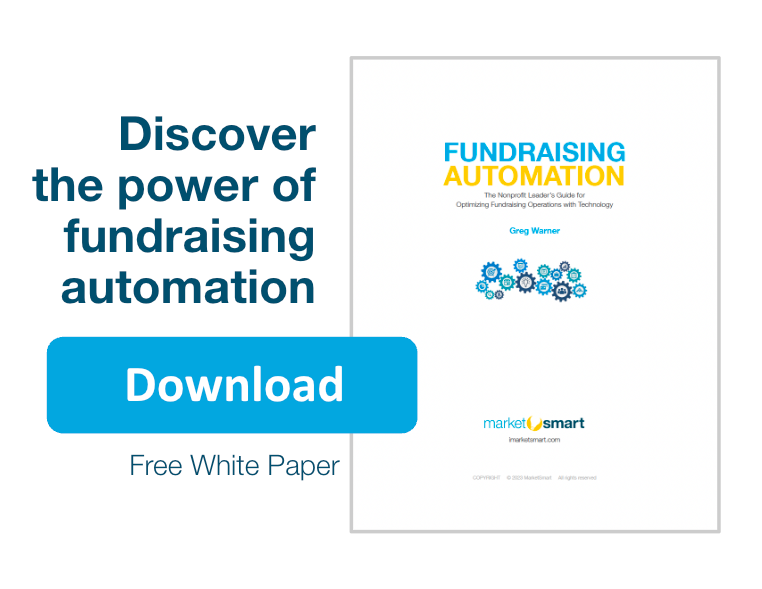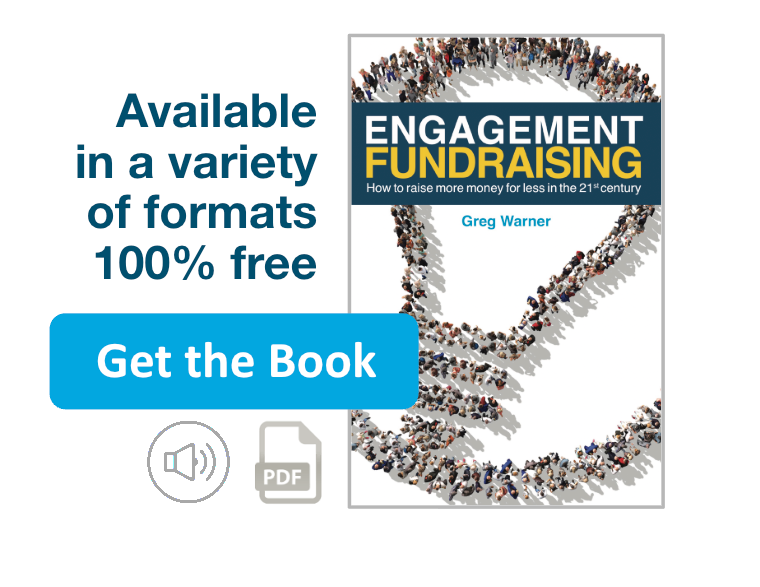Seth Godin is pretty smart. He really understands marketing.
In his recent blog post he discusses why we should sometimes avoid “easy leads” and, rather, seek to qualify our leads more vigorously. But when it comes to planned giving marketing, I feel that what he’s talking about and what we’re doing are very different.
First let me point out that my firm used to be a bare-knuckle marketing “hired gun” for some of the toughest businesses in the Washington, DC region. Back then we were mostly doing hardcore lead generation. One of our clients was a home improvement company. For them, we had to find ways to find “highly qualified” leads. The cost of sending someone out to a home to quote on a job that averaged only $3,000-$10,000 was just too high. So, we tested adding questions to our surveys on landing pages. Then we arranged for telephone calls to follow up on every lead (to ensure that both decision-makers of the household were present before sending a sales rep out the door). Then just before the sales person left to go meet them, again we’d confirm that all the decision-makers would be present.
Now, for our marketing planned gifts, the “sale” is very different. We’re not selling a product but rather a life choice and a large investment. We’re aiming to help people align their legacy mission with that of the nonprofit we serve. So we need to widen the funnel a lot. Then we need to cultivate the relationships (possibly for many years) with financial/educational information, mission-oriented information and conversion-oriented options (to get folks to raise their hands) because:
1- You never know which ones of these leads are just tire-kickers and which ones will leave a gift. Some people might say they will not leave a gift only because they don’t want phone calls. They just want to be anonymous.
2- For most folks it’s a HUGE jump forward to request this information at all. By doing so they are moving from the avoidance stage to the consideration stage of a very long and emotional, non-measured (even erratic) decision-making process. Considering the fact that over 50% of Americans never create a will at all, the fact that they are requesting this information is simply tremendous. This point should not be overlooked and all of these leads should be treated like gold.
3- It takes time. Some people will act right away to make a legacy gift decision. But most people will skim the information an organization sends out in response to requests and soon put it all in a drawer. Hopefully it’s near their tax information or their legal stuff. But, yes… that’s right… it will probably sit in a drawer.
4- Here’s where the magic happens. When your organization takes the effort to remind these leads about the planned giving concept and seek ways to get them to educate themselves further about the benefits they would enjoy (for their soul and their pocket-book), something special happens. I know it’s time consuming and tedious. But the largest and most impactful gifts happen in the minds of your donors when you are not there. It’s a slow process. It requires frequency and repetition. It requires well-conceived messages. And it always must include easy ways for people to move to the next step in the consideration process. In planned giving marketing we must treat each lead as if it holds the potential for a $1 million gift. Cultivate a relationship with each one properly over time and, because it’s a numbers game, you WILL end up with boatloads of money for your organization.
5- Most importantly, this “sale” usually happens when no one from the organization is around. Simply stated, most folks don’t need to involve you and your staff in order to make this kind of gift/investment. That’s the hardest part to grasp but the critical reason why this “sale” is so different from what Seth Godin is talking about.
For more on the slow sale concept, read about the tortoise and the hare in planned giving marketing here.
Related Posts
>> How to overcome the misconceptions about fundraising and selling
>> The Difference Between Fundraising and Selling






This well-articulated article finally provides an insightful explanation why the process of “selling” planned gifts is so unique in the world of commerce. This article should be required reading for the many commercial bean counters who have relocated from wall street into the nonprofit world and are now supervising planned gift officers throughout the land.
We all know the nonprofit boss who tries to push planned gift officers to close deals like we were selling used cars. They are mired in the philosophies that have been used for generations to sell retail goods. These are the managers who expect planned gift officers to complete a minimum number of calls per day, visits per week, and new commitments each month. These are the professional “bean counters” who have convinced nonprofit boards and CEOs that they can increase the productivity of the planned giving shop by treating planned gifts as widgets to be sold like used cars.
I do not recall the source, and the stats may be old (please update me if you have current data), but the average full-time Planned Giving officer stays in their position for an average of 2.9 years, yet the average major planned gift takes an average of 3.9 years from the first contact to “close”. The organizations who have allowed these commercial hucksters to overtake our industry have created a workplace that is untenable. They do not understand the reality that what we do is not “transactional” but “relational” in nature. They come into an organization promising big numbers and immediate returns. They are harming the future of their organizations by insisting on short-term pressures to close the deal. It seems that they have a mental block and cannot grasp the fact that donors give when they want to, not because your boss has pressured you to meet a goal.
Until the bean counters who now administer nonprofit planned giving shops understand the difference between commercial sales and planned gift marketing, we will continue to see the churning within our industry as the great planned gift officers seek a work environment where they are encouraged to take the long-term approach to securing planned gifts, and where adequate support is allowed to steward those donors for life.
Thanks for the useful “brain food,” Greg. I hope it turns into food fight throughout our industry…
One thing I left out. Most of us will not even be on this earth to see the fruits of our labor.
Your remarks show what a long way you’ve come from the hard sell of a “hired gun”. Great points and right on the mark. Thanks Greg.
Thanks Lorri. You and I always seem to agree.
Greg W.,
I think the analogy is useful. Over time I’d like to see something even better developed that removes the facetious elements of the hare so those falling into the camp are less defensive and open to persuasion.
Steve,
Bean counting isn’t inherently evil … counting the right beans can be very productive. I DO understand where you’re coming from and you accurately portray an all-to-current approach.
So, what is good bean counting? It’s the type of moves management in which legacy asks are made in person and over the phone by those who have relationships, or through referrals. The beans are counted in a moves management system that recognizes that more than half of all qualified leads will make a legacy gift when the timing is right for THEM. When is this? Three months? Three years? Longer? YES.
This well-articulated article finally provides an insightful explanation why the process of “selling” planned gifts is so unique in the world of commerce. This article should be required reading for the many commercial bean counters who have relocated from wall street into the nonprofit world and are now supervising planned gift officers throughout the land.
We all know the nonprofit boss who tries to push planned gift officers to close deals like we were selling used cars. They are mired in the philosophies that have been used for generations to sell retail goods. These are the managers who expect planned gift officers to complete a minimum number of calls per day, visits per week, and new commitments each month. These are the professional “bean counters” who have convinced nonprofit boards and CEOs that they can increase the productivity of the planned giving shop by treating planned gifts as widgets to be sold like used cars.
I do not recall the source, and the stats may be old (please update me if you have current data), but the average full-time Planned Giving officer stays in their position for an average of 2.9 years, yet the average major planned gift takes an average of 3.9 years from the first contact to “close”. The organizations who have allowed these commercial hucksters to overtake our industry have created a workplace that is untenable. They do not understand the reality that what we do is not “transactional” but “relational” in nature. They come into an organization promising big numbers and immediate returns. They are harming the future of their organizations by insisting on short-term pressures to close the deal. It seems that they have a mental block and cannot grasp the fact that donors give when they want to, not because your boss has pressured you to meet a goal.
Until the bean counters who now administer nonprofit planned giving shops understand the difference between commercial sales and planned gift marketing, we will continue to see the churning within our industry as the great planned gift officers seek a work environment where they are encouraged to take the long-term approach to securing planned gifts, and where adequate support is allowed to steward those donors for life.
Thanks for the useful “brain food,” Greg. I hope it turns into food fight throughout our industry…
One thing I left out. Most of us will not even be on this earth to see the fruits of our labor.
Your remarks show what a long way you’ve come from the hard sell of a “hired gun”. Great points and right on the mark. Thanks Greg.
Thanks Lorri. You and I always seem to agree.
Greg W.,
I think the analogy is useful. Over time I’d like to see something even better developed that removes the facetious elements of the hare so those falling into the camp are less defensive and open to persuasion.
Steve,
Bean counting isn’t inherently evil … counting the right beans can be very productive. I DO understand where you’re coming from and you accurately portray an all-to-current approach.
So, what is good bean counting? It’s the type of moves management in which legacy asks are made in person and over the phone by those who have relationships, or through referrals. The beans are counted in a moves management system that recognizes that more than half of all qualified leads will make a legacy gift when the timing is right for THEM. When is this? Three months? Three years? Longer? YES.